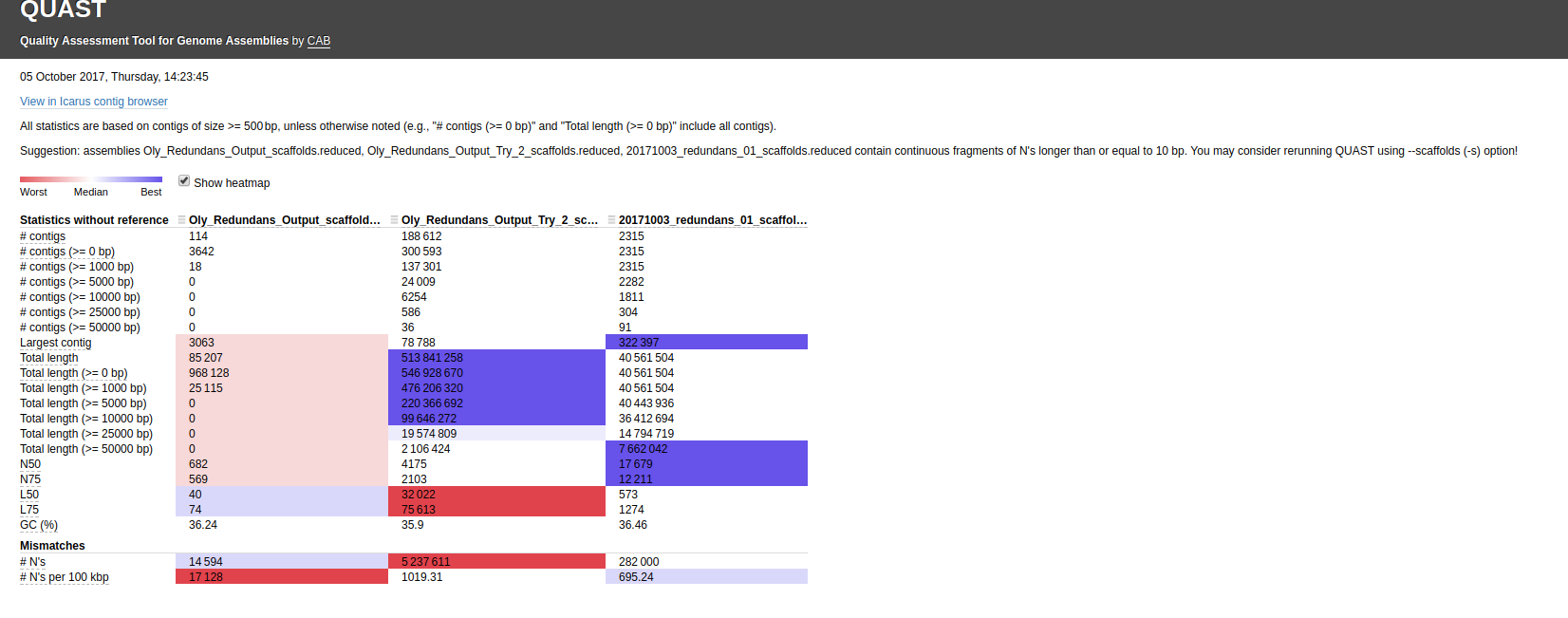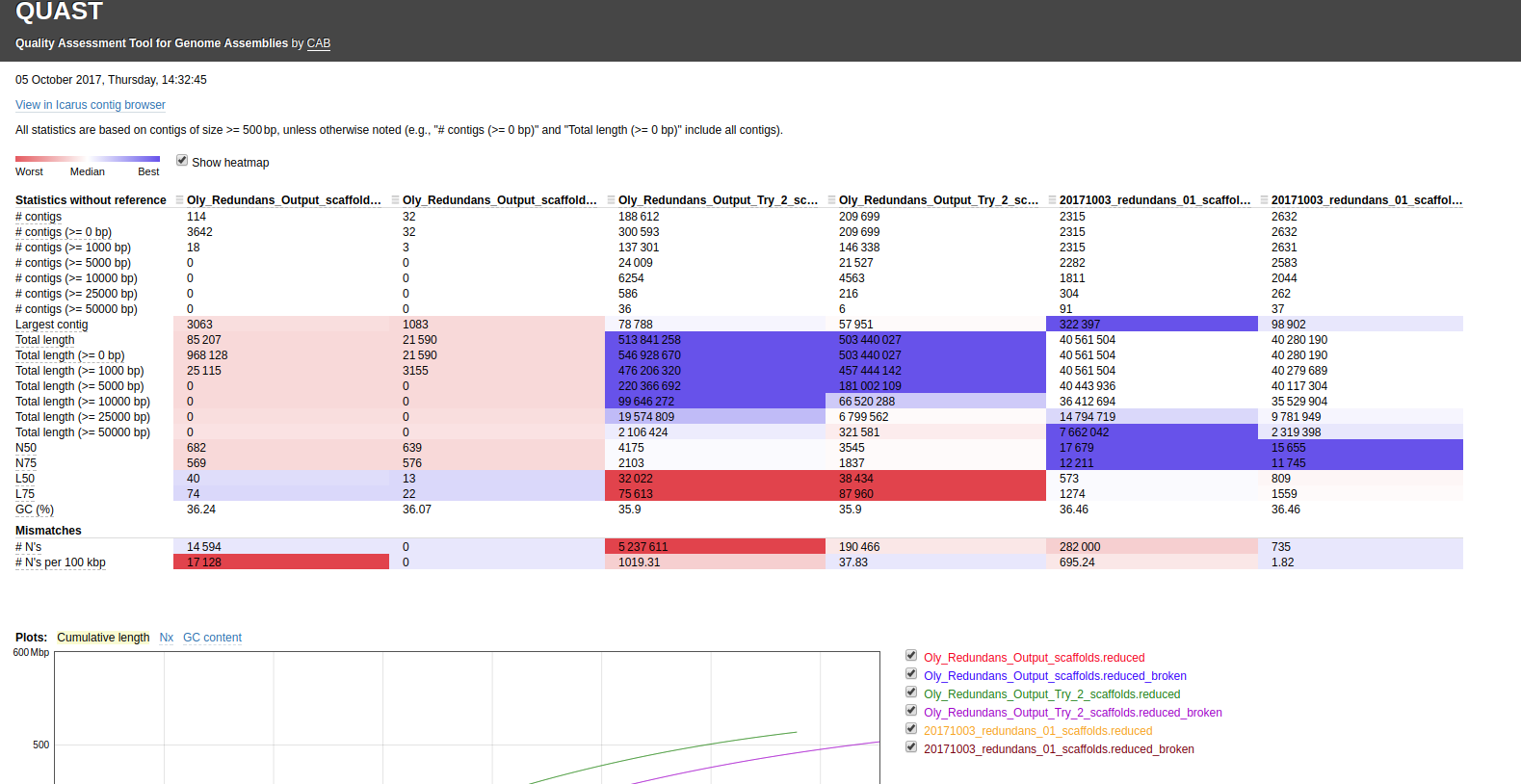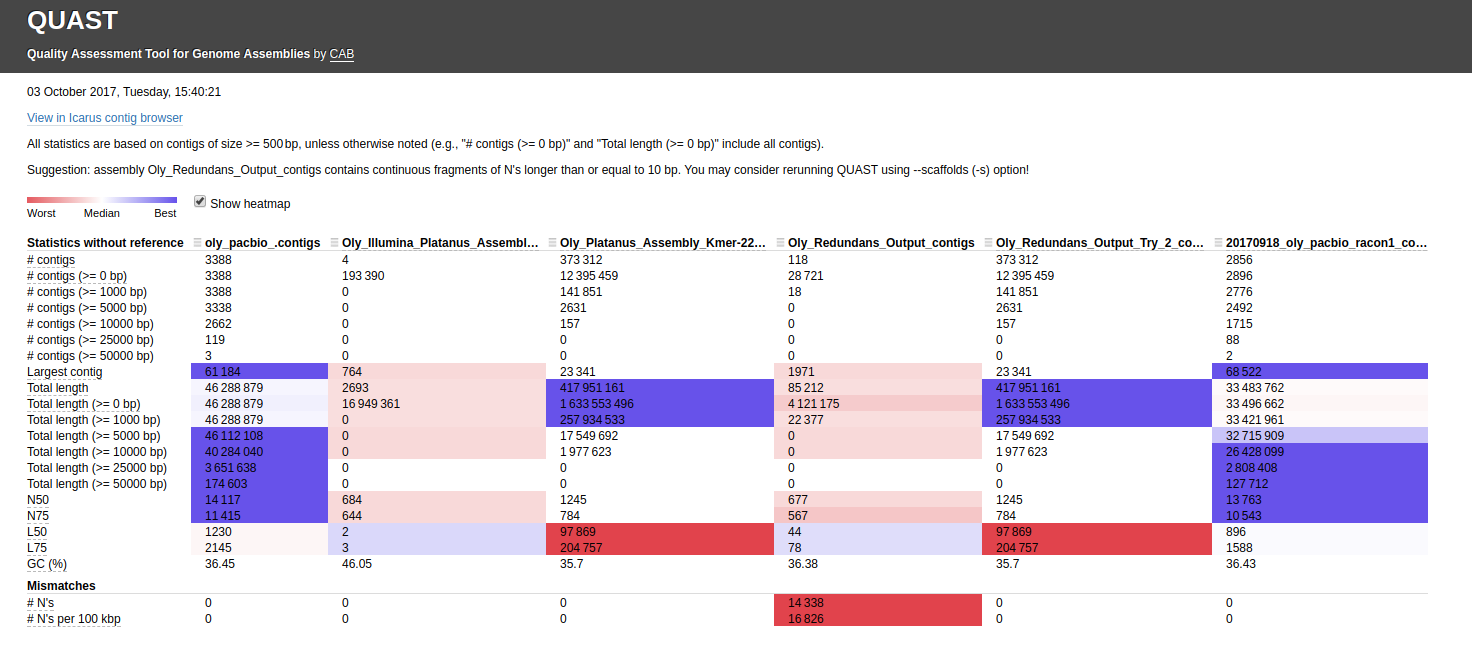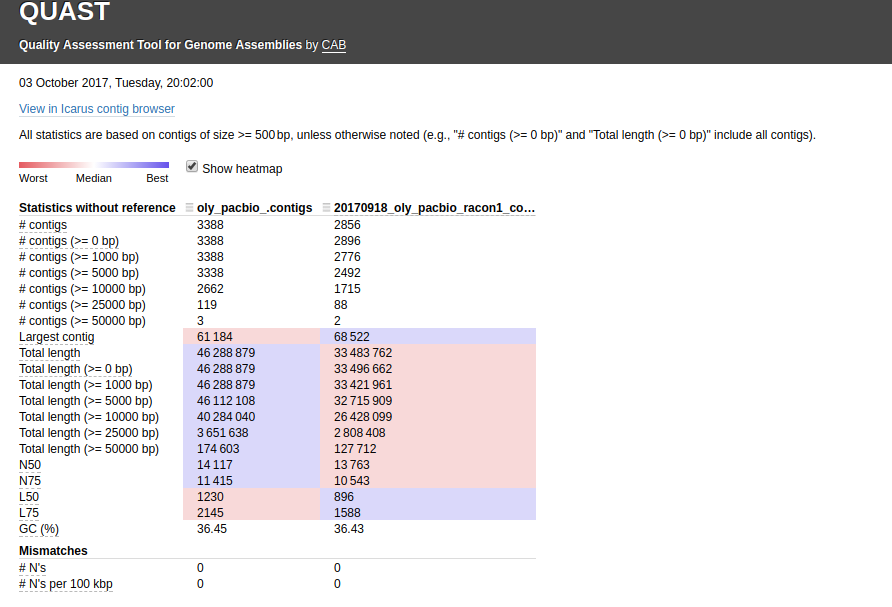Steven asked me to evaluate our methylation sequencing data sets for Olympia oyster.
According to our Olympia oyster genome wiki, we have the following two sets of BS-seq data:
All computing was conducted on our Apple Xserve: emu.
All steps were documented in this Jupyter Notebook (GitHub): 20180503_emu_oly_methylation_mapping.ipynb
NOTE: The Jupyter Notebook linked above is very large in size. As such it will not render on GitHub. It will need to be downloaded to a computer that can run Jupyter Notebooks and viewed that way.
Here’s a brief overview of what was done.
Samples were trimmed with TrimGalore and then evaluated with FastQC. MultiQC was used to generate a nice visual summary report of all samples.
The Olympia oyster genome assembly, pbjelly_sjw_01, was used as the reference genome and was prepared for use in Bismark:
/home/shared/Bismark-0.19.1/bismark_genome_preparation \
--path_to_bowtie /home/shared/bowtie2-2.3.4.1-linux-x86_64/ \
--verbose /home/sam/data/oly_methylseq/oly_genome/ \
2> 20180507_bismark_genome_prep.err
Bismark was run on trimmed samples with the following command:
/home/shared/Bismark-0.19.1/bismark \
--path_to_bowtie /home/shared/bowtie2-2.3.4.1-linux-x86_64/ \
--genome /home/sam/data/oly_methylseq/oly_genome/ \
-u 1000000 \
-p 16 \
--non_directional \
/home/sam/analyses/20180503_oly_methylseq_trimgalore/1_ATCACG_L001_R1_001_trimmed.fq.gz \
/home/sam/analyses/20180503_oly_methylseq_trimgalore/2_CGATGT_L001_R1_001_trimmed.fq.gz \
/home/sam/analyses/20180503_oly_methylseq_trimgalore/3_TTAGGC_L001_R1_001_trimmed.fq.gz \
/home/sam/analyses/20180503_oly_methylseq_trimgalore/4_TGACCA_L001_R1_001_trimmed.fq.gz \
/home/sam/analyses/20180503_oly_methylseq_trimgalore/5_ACAGTG_L001_R1_001_trimmed.fq.gz \
/home/sam/analyses/20180503_oly_methylseq_trimgalore/6_GCCAAT_L001_R1_001_trimmed.fq.gz \
/home/sam/analyses/20180503_oly_methylseq_trimgalore/7_CAGATC_L001_R1_001_trimmed.fq.gz \
/home/sam/analyses/20180503_oly_methylseq_trimgalore/8_ACTTGA_L001_R1_001_trimmed.fq.gz \
/home/sam/analyses/20180503_oly_methylseq_trimgalore/zr1394_10_s456_trimmed.fq.gz \
/home/sam/analyses/20180503_oly_methylseq_trimgalore/zr1394_11_s456_trimmed.fq.gz \
/home/sam/analyses/20180503_oly_methylseq_trimgalore/zr1394_12_s456_trimmed.fq.gz \
/home/sam/analyses/20180503_oly_methylseq_trimgalore/zr1394_13_s456_trimmed.fq.gz \
/home/sam/analyses/20180503_oly_methylseq_trimgalore/zr1394_14_s456_trimmed.fq.gz \
/home/sam/analyses/20180503_oly_methylseq_trimgalore/zr1394_15_s456_trimmed.fq.gz \
/home/sam/analyses/20180503_oly_methylseq_trimgalore/zr1394_16_s456_trimmed.fq.gz \
/home/sam/analyses/20180503_oly_methylseq_trimgalore/zr1394_17_s456_trimmed.fq.gz \
/home/sam/analyses/20180503_oly_methylseq_trimgalore/zr1394_18_s456_trimmed.fq.gz \
/home/sam/analyses/20180503_oly_methylseq_trimgalore/zr1394_1_s456_trimmed.fq.gz \
/home/sam/analyses/20180503_oly_methylseq_trimgalore/zr1394_2_s456_trimmed.fq.gz \
/home/sam/analyses/20180503_oly_methylseq_trimgalore/zr1394_3_s456_trimmed.fq.gz \
/home/sam/analyses/20180503_oly_methylseq_trimgalore/zr1394_4_s456_trimmed.fq.gz \
/home/sam/analyses/20180503_oly_methylseq_trimgalore/zr1394_5_s456_trimmed.fq.gz \
/home/sam/analyses/20180503_oly_methylseq_trimgalore/zr1394_6_s456_trimmed.fq.gz \
/home/sam/analyses/20180503_oly_methylseq_trimgalore/zr1394_7_s456_trimmed.fq.gz \
/home/sam/analyses/20180503_oly_methylseq_trimgalore/zr1394_8_s456_trimmed.fq.gz \
/home/sam/analyses/20180503_oly_methylseq_trimgalore/zr1394_9_s456_trimmed.fq.gz \
2> 20180507_bismark_02.err
Results:
TrimGalore output folder:
FastQC output folder:
MultiQC output folder:
MultiQC Report (HTML):
Bismark genome folder: 20180503_oly_genome_pbjelly_sjw_01_bismark/
Bismark output folder:
Whole genome BS-seq (2015)
Prep overview
- Library prep: Roberts Lab
- Sequencing: Genewiz
| Bismark Report | Mapping Percentage |
|---|---|
| 1_ATCACG_L001_R1_001_trimmed_bismark_bt2_SE_report.txt | 40.3% |
| 2_CGATGT_L001_R1_001_trimmed_bismark_bt2_SE_report.txt | 39.9% |
| 3_TTAGGC_L001_R1_001_trimmed_bismark_bt2_SE_report.txt | 40.2% |
| 4_TGACCA_L001_R1_001_trimmed_bismark_bt2_SE_report.txt | 40.4% |
| 5_ACAGTG_L001_R1_001_trimmed_bismark_bt2_SE_report.txt | 39.9% |
| 6_GCCAAT_L001_R1_001_trimmed_bismark_bt2_SE_report.txt | 39.6% |
| 7_CAGATC_L001_R1_001_trimmed_bismark_bt2_SE_report.txt | 39.9% |
| 8_ACTTGA_L001_R1_001_trimmed_bismark_bt2_SE_report.txt | 39.7% |
MBD BS-seq (2015)
Prep overview
- MBD: Roberts Lab
- Library prep: ZymoResearch
- Sequencing: ZymoResearch
| Bismark Report | Mapping Percentage |
|---|---|
| zr1394_1_s456_trimmed_bismark_bt2_SE_report.txt | 33.0% |
| zr1394_2_s456_trimmed_bismark_bt2_SE_report.txt | 34.1% |
| zr1394_3_s456_trimmed_bismark_bt2_SE_report.txt | 32.5% |
| zr1394_4_s456_trimmed_bismark_bt2_SE_report.txt | 32.8% |
| zr1394_5_s456_trimmed_bismark_bt2_SE_report.txt | 35.2% |
| zr1394_6_s456_trimmed_bismark_bt2_SE_report.txt | 35.5% |
| zr1394_7_s456_trimmed_bismark_bt2_SE_report.txt | 32.8% |
| zr1394_8_s456_trimmed_bismark_bt2_SE_report.txt | 33.0% |
| zr1394_9_s456_trimmed_bismark_bt2_SE_report.txt | 34.7% |
| zr1394_10_s456_trimmed_bismark_bt2_SE_report.txt | 34.9% |
| zr1394_11_s456_trimmed_bismark_bt2_SE_report.txt | 30.5% |
| zr1394_12_s456_trimmed_bismark_bt2_SE_report.txt | 35.8% |
| zr1394_13_s456_trimmed_bismark_bt2_SE_report.txt | 32.5% |
| zr1394_14_s456_trimmed_bismark_bt2_SE_report.txt | 30.8% |
| zr1394_15_s456_trimmed_bismark_bt2_SE_report.txt | 31.3% |
| zr1394_16_s456_trimmed_bismark_bt2_SE_report.txt | 30.7% |
| zr1394_17_s456_trimmed_bismark_bt2_SE_report.txt | 32.4% |
| zr1394_18_s456_trimmed_bismark_bt2_SE_report.txt | 34.9% |






